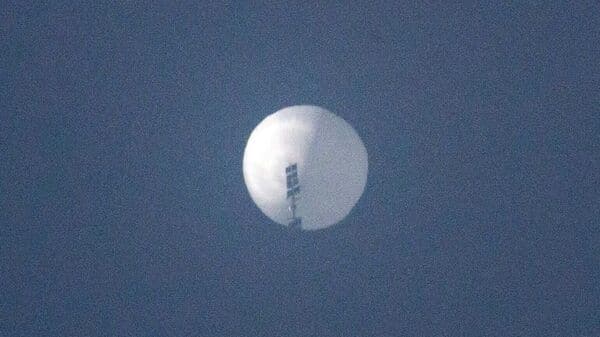Chinese spy balloon floating over the US: What we know so far
The US Defense Department said Thursday it’s monitoring a suspected Chinese surveillance balloon floating over the western state of Montana, underscoring mutual suspicion between the world’s two largest economies just as top diplomats prepare to hold talks in Beijing. Here’s everything we know so far:

1) What’s a surveillance balloon?
Cheap, quiet and hard to reach — balloons have long been used for reconnaissance purposes, including in conflicts like the American Civil War. The practice became widespread during World War I and was used extensively during the Cold War, when the US launched hundreds of balloons to gather intelligence on the Soviet Union and China. While their use has declined with the rise of unmanned drones and satellites, many countries still employ spy balloons. The Pentagon is expanding investment in high-altitude inflatables, Politico reported last year. Modern balloons are generally unmanned, but they still generally lack propulsion and are subject to wind currents.
2) What do we know about the balloon floating over the US?
The Biden administration disclosed the balloon’s existence Thursday, saying it was spotted earlier the week and most recently seen floating more than 40,000 feet (12,000 meters) over Montana. The location is sensitive, since the state is home to the Air Force’s 341st Missile Wing and its Minuteman III intercontinental ballistic missiles. While China hasn’t yet commented on the incident, a Defense Department spokesman said the US had high confidence it belonged to the country, without explaining why.
3) Is the balloon a security threat?
Details on the exact capabilities of this particular balloon are unclear, with a US official who briefed reporters Thursday declining to answer several questions about its size or specifications. American officials have asserted that the balloon has a limited ability to collect meaningful intelligence data, beyond what the Chinese can already gather through their satellite network. The North American Aerospace Defense Command, or Norad, said Thursday it “continues to track and monitor it closely,” while Canada’s defense department said it was tracking a “potential second incident,” without elaborating.
4) Why has China sent the balloon up now?
The Chinese have for decades complained about US surveillance by ships and spy planes near its own territory, leading to occasional confrontation over the years. And instances of Chinese balloon activity near American territory have been observed prior to Thursday’s announcement, US officials said. But it’s unclear why the balloon is flying over the US at this moment. The revelation comes just days before US Secretary of State Antony Blinken’s expected visit to Beijing and risks undermining Beijing’s diplomatic efforts to create a constructive backdrop for the first US secretary of state visit to China since Michael Pompeo’s trip in 2018.
5) Why hasn’t the Pentagon shot the balloon down?
Defense Secretary Lloyd Austin advised President Joe Biden against shooting the balloon down because of the possible risk of falling debris. While authorities were contemplating the option when the balloon was floating over sparsely populated areas of Montana, it was assessed that the “sizable” object was large enough to cause potential damage. It’s floating well above the altitude used by civilian aircraft, so is unlikely to pose any immediate danger to the public.
6) How has the US responded?
The senior official said the US had raised the balloon issue with China, and the Wall Street Journal reported that the State Department had summoned the Chinese charge d’affaires. It wasn’t immediate clear if the incident would affect Blinken’s planned trip to China. The Biden administration also briefed staff for the “Gang of Eight,” a group including the chairs and ranking members of the House and Senate intelligence committees, another official said. Republicans, meanwhile, are pushing Biden for a stronger response, with House Speaker Kevin McCarthy calling the incursion a “brazen disregard for US sovereignty.”


